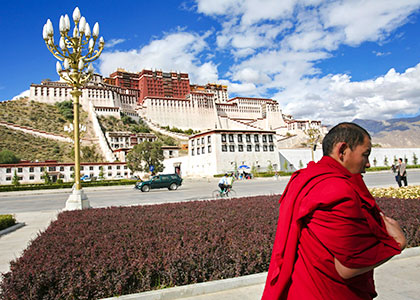Himalaya Adventure from Tibet to Nepal
7 Days Small Group Tour of Lhasa - Gyantse - Shigatse - Mt. Everest - Kyirong Border - Kathmandu
Tour Type: Small group of about 12 persons, guaranteed departures
Guide: Professional English-speaking tour guide
Transportation: Spacious air-conditioned vehicle with experienced driver
Accommodation: 6 nights at good economy class hotels
Meals: 6 breakfasts, 1 lunch, and 1 dinner
Code: TG04
Guide: Professional English-speaking tour guide
Transportation: Spacious air-conditioned vehicle with experienced driver
Accommodation: 6 nights at good economy class hotels
Meals: 6 breakfasts, 1 lunch, and 1 dinner
Code: TG04
From USD969 per person Free Inquiry
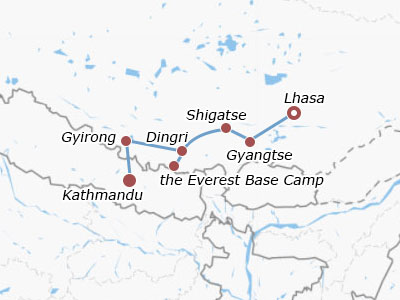
- Itinerary
- Dates & Prices
- Reviews
Trip Highlights
- Gain insights into architectural essence and art treasures in Potala Palace.
- Take in the brilliant monastic debate on Buddhist doctrines in Sera Monastery.
- Delve into Tibetan culture and life with a local family visit and sweet tea tasting.
- Appreciate fascinating lakes, glaciers, and snow mountains on the way to Shigatse.
- Camp at the foot of Mt. Everest and enjoy sunrise and sunset over it.
Expand All
Collapse All
Day 1 Arrival in Lhasa
Tibet sincerely invites you to witness its mysterious religious buildings, spectacular snow-capped mountains, and serene sacred lakes! Upon your arrival in its capital, Lhasa, our guide will pick you up from the exit of the Lhasa Gonggar Airport or the railway station, and then escort you to the hotel downtown. After helping you check in, we will leave the remainder of the day free for you to rest in the hotel and acclimate to the high altitude here.
► Note on Pick-up Service:
For the transfer service from the airport to the hotel, what we will provide for you is the minivan or minibus that departs at fixed times of 10:00, 13:30, 16:00, and 18:30 and is determined by the number of arriving guests at the same time. If you arrive by train, you’ll be taken to the hotel as soon as the guide picks you up. If a private transfer is what you wish, please let us know in advance.
► Pay Attention to Possible Altitude Sickness:
Tibet is located in a plateau area with an average altitude of over 4,000 meters (13,123 feet), and more specifically, during our trip from Lhasa to the Everest Base Camp, the altitude will rise from 3,650 meters (11,975 feet) to 5,200 meters (17,060 feet), which means the air will gradually become thinner and thinner. Therefore, altitude sickness, including symptoms such as headache, fatigue, breathing difficulties, nausea, and vomiting, may be something we have to face. Before your departure, it is very necessary to have a physical examination, prepare some relevant drugs like Rhodiola, and do appropriate aerobic exercises like jogging and swimming. After entering Tibet, be sure to keep adequate rest, consume more high-carbohydrates and water, and avoid strenuous exercise, alcohol, and tobacco. When you feel unwell, inform the guide in time to get help.
About Accommodation: What we arrange are economy hotels with the best value. We also have comfort hotel options. If you want to upgrade to better hotels, please let your travel consultant know, and he/she is ready to assist anytime.
Accommodation: Xinding Hotel Lhasa (4 stars) or similar
► Note on Pick-up Service:
For the transfer service from the airport to the hotel, what we will provide for you is the minivan or minibus that departs at fixed times of 10:00, 13:30, 16:00, and 18:30 and is determined by the number of arriving guests at the same time. If you arrive by train, you’ll be taken to the hotel as soon as the guide picks you up. If a private transfer is what you wish, please let us know in advance.
► Pay Attention to Possible Altitude Sickness:
Tibet is located in a plateau area with an average altitude of over 4,000 meters (13,123 feet), and more specifically, during our trip from Lhasa to the Everest Base Camp, the altitude will rise from 3,650 meters (11,975 feet) to 5,200 meters (17,060 feet), which means the air will gradually become thinner and thinner. Therefore, altitude sickness, including symptoms such as headache, fatigue, breathing difficulties, nausea, and vomiting, may be something we have to face. Before your departure, it is very necessary to have a physical examination, prepare some relevant drugs like Rhodiola, and do appropriate aerobic exercises like jogging and swimming. After entering Tibet, be sure to keep adequate rest, consume more high-carbohydrates and water, and avoid strenuous exercise, alcohol, and tobacco. When you feel unwell, inform the guide in time to get help.
About Accommodation: What we arrange are economy hotels with the best value. We also have comfort hotel options. If you want to upgrade to better hotels, please let your travel consultant know, and he/she is ready to assist anytime.
Accommodation: Xinding Hotel Lhasa (4 stars) or similar
Day 2 Lhasa
Morning visit to the Drepung Monastery. In the afternoon, admire the Sera Monastery and watch the monks’ debate activities. (B+D)
Today, let’s embark on an excursion in the western suburbs of Lhasa, where you’ll be welcomed by Drepung Monastery first. Built in dense layers against mountains, it is not only the largest Tibetan Buddhist temple but also the most prestigious one of the Gelug Sect. After visiting the three-story flat-roofed Ganden Potrang, which was once the home of the second to fifth Dalai Lamas, we will come to the ‘heart’ of the temple, the Coqen Hall. Walking inside, you may find that even though butter lamps are lit in front of Buddha statues, it is still dark, perhaps because there are too many big hangings. While admiring its walls decorated with exquisite Thangka murals, your eyes will also be drawn occasionally by the Tibetans who are adding the butter contained in their own bottles to each lamp. This is their unique way of paying homage to the Buddha and praying for blessings. Then, in various Zhacangs, that is, academies, also observe the lamas’ daily study of the classics. If your Tibet trip is in July or August, you’ll have a chance to rejoice in the traditional Tibetan Shoton Festival, also known as the ‘Yogurt Day’, which is celebrated with great fanfare here every year. Apart from appreciating a giant silk tapestry of the Buddha, expect to enjoy fascinating Tibetan operas and folk music and dance as well.
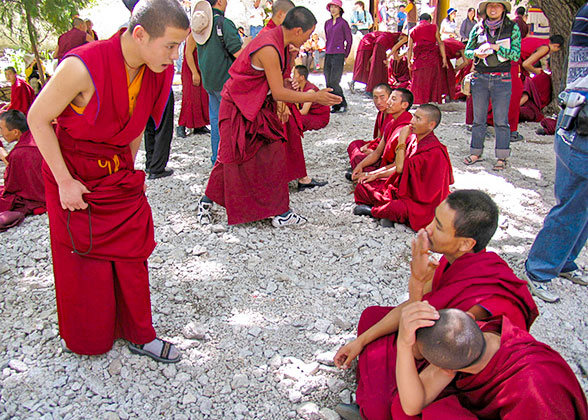 In the afternoon, move to Sera Monastery, which is the last of the ‘Three Great Monasteries’ of Lhasa (the other two being Drepung Monastery and Gandan Monastery) to be built. In 1415, when Zhu Di, the third emperor of the Ming Dynasty (1368 - 1644), was ill, Jamchen Chojey, a disciple of Master Tsong Khapa, went to the imperial palace to perform religious rituals for him, was awarded a large fortune after his recovery, and then began to build the Monastery in the fourth year. Until now, it has always been the most famous place for holding debates on Buddhist doctrines. At 15:00 every afternoon except Sunday, the wooden door of the debating courtyard would be pulled open with a creak, and then the red-robed monks would file in. “Pop!” A clap of hands breaks the silence. When dozens of red-clad lamas gather in pairs under the shade of trees to loudly discuss the Dharma, the ‘flames’ of speculation that emanate from them might instantly ignite your most fresh perception of Tibetan Buddhism! Although you can’t understand their language, seeing that intense scene, their excited expressions, and exaggerated movements, you are sure to be shocked.
In the afternoon, move to Sera Monastery, which is the last of the ‘Three Great Monasteries’ of Lhasa (the other two being Drepung Monastery and Gandan Monastery) to be built. In 1415, when Zhu Di, the third emperor of the Ming Dynasty (1368 - 1644), was ill, Jamchen Chojey, a disciple of Master Tsong Khapa, went to the imperial palace to perform religious rituals for him, was awarded a large fortune after his recovery, and then began to build the Monastery in the fourth year. Until now, it has always been the most famous place for holding debates on Buddhist doctrines. At 15:00 every afternoon except Sunday, the wooden door of the debating courtyard would be pulled open with a creak, and then the red-robed monks would file in. “Pop!” A clap of hands breaks the silence. When dozens of red-clad lamas gather in pairs under the shade of trees to loudly discuss the Dharma, the ‘flames’ of speculation that emanate from them might instantly ignite your most fresh perception of Tibetan Buddhism! Although you can’t understand their language, seeing that intense scene, their excited expressions, and exaggerated movements, you are sure to be shocked.
Can’t wait to treat your stomach to some authentic Tibetan dishes? Then let’s make a beeline for a well-regarded local restaurant right now and enjoy a welcome dinner we have carefully prepared for you.
Meals: Western buffet breakfast, Welcome dinner
Accommodation: Xinding Hotel Lhasa (4 stars) or similar

Sera Temple

Monks Debating in Sera Temple
Can’t wait to treat your stomach to some authentic Tibetan dishes? Then let’s make a beeline for a well-regarded local restaurant right now and enjoy a welcome dinner we have carefully prepared for you.
Meals: Western buffet breakfast, Welcome dinner
Accommodation: Xinding Hotel Lhasa (4 stars) or similar
Day 3 Lhasa
Visit Potala Palace, Jokhang Temple, and Barkhor Street. Have a tea break at a sweet tea house. (B)
Ascending to the Potala Palace
► Due to the tight supply of tickets for the Potala Palace, we cannot fully confirm the reserved date in advance, which may lead to a slight adjustment to the visiting order of the itinerary. But please rest assured that we’ll ensure you enjoy a seamless journey without missing any sights.
Next, we will go down to Zongjiao Lukang Park at the foot of the palace, where there are many people dressed in ethnic costumes dancing the traditional Guozhuang to the pleasant Tibetan music every day. They form a circle on the square with white shed, constantly swinging their hands, turning their waists and raising their legs, as if they are freely showing their talents on the grassland under the white clouds.
After lunch, follow our guide to explore the Jokhang Temple, which is Tibet’s most refulgent structure surviving from the Tupo Period in the 7th century, integrating architectural styles of Tibet, the Tang Dynasty (618 - 907) of China, Nepal, and India. Interestingly, there has been a widespread Tibetan saying that “The Jokhang Temple first, then the Lhasa City”. Over 1,300 years ago, to enshrine the life-sized statue of eight-year-old Sakyamuni brought from Nepal by Princess Chizun, King Songtsen Gampo of Tibet planned to build a temple. He tossed his ring to determine the site - on a lake, which was later filled with earth carried by goats. After the temple was built, it was named Resa (‘re’ means ‘goat’ and ‘sa’ means ‘earth’ in Tibetan) in commemoration, which eventually evolved into the current city name, Lhasa. Here, the golden roofs of the main hall glitter brightly in the sunlight, the prayer flags on the walls flutter in the gentle breeze, and the bells at the four eaves jingle, making you feel as if you were in an unparalleled Buddhist kingdom.
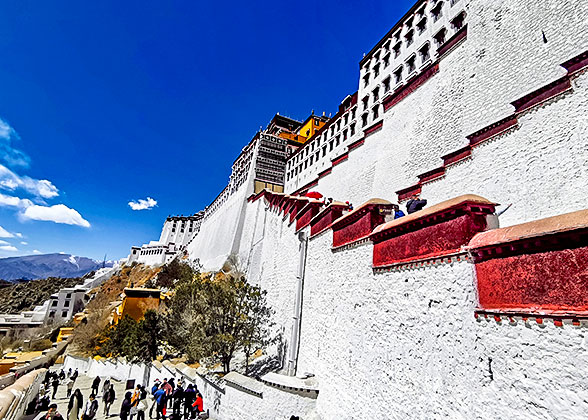
Potala Palace

Jokhang Temple
Meals: Western buffet breakfast, Tea break
Accommodation: Xinding Hotel Lhasa (4 stars) or similar
Day 4 Lhasa - Gyantse - Shigatse
Head to Gyantse and visit Yamdrok Yumco Lake en route. Visit a local family by the lake and enjoy a farm lunch. Pass the Karola Glacier and Gyantse barley farm land to reach Shigatse. (B+L)
After breakfast, we’ll set out for a comfortable drive to Shigatse, the second largest city in Tibet. En route, we won’t let you miss the Yamdrok Yumco Lake, one of the Great Three Holy Lakes in Tibet, which looks like an azure ribbon nestling in the arms of rolling mountains. With our guide, ascend the Gampala Pass Platform, where the best panoramic view of the Lake is offered. Looking down from the top, the lake water shows various shades of blue, as if the rarest colors on a palette have been generously painted on this plateau by nature. When taking a walk along the lakeside, with each step on the soft grass and the gurgling sound of the flowing water in your ears, you may get a moment's peace of mind. Go into a local family, enjoy a sumptuous farm lunch, and learn from them to pronounce their classic greeting words - Tashi Delek!
Keep moving forward for a short while, the ice tongue of the Karola Glacier, just a few hundred meters away from the road, will come into view. The blue-white ice surface is covered with some dark brown glacial tills, which are right the marks left by the glacial movement. Looking up, you’ll feel as if the entire glacier is about to rush down towards you from the mountains with the biting cold. However, alas, there is a distinct triangular gap on the ice tongue, which is said to be an unhealable scar left by explosives in pursuit of the so-called ‘avalanche effect’ during the shooting of the Chinese film ‘Red River Valley’. Also, you can have a distant view of the vast barley fields at the foot of the glacier, presenting a natural artistic beauty as the terrain undulates. When arriving at Shigatse, check in at the hotel and have a good rest.
Meals: Western buffet breakfast, Farm house Lunch
Accommodation: Shiga-Yangcha Hotel Shigatse (3 stars) or similar
Keep moving forward for a short while, the ice tongue of the Karola Glacier, just a few hundred meters away from the road, will come into view. The blue-white ice surface is covered with some dark brown glacial tills, which are right the marks left by the glacial movement. Looking up, you’ll feel as if the entire glacier is about to rush down towards you from the mountains with the biting cold. However, alas, there is a distinct triangular gap on the ice tongue, which is said to be an unhealable scar left by explosives in pursuit of the so-called ‘avalanche effect’ during the shooting of the Chinese film ‘Red River Valley’. Also, you can have a distant view of the vast barley fields at the foot of the glacier, presenting a natural artistic beauty as the terrain undulates. When arriving at Shigatse, check in at the hotel and have a good rest.
Meals: Western buffet breakfast, Farm house Lunch
Accommodation: Shiga-Yangcha Hotel Shigatse (3 stars) or similar
Day 5 Shigatse - Dingri - Everest Base Camp
Visit Tashilunpo Monastery before heading to the Himalayas. Admire the Himalayas including the Mt. Everest at two view points in Dingri. Enjoy sunset at Everest Base Camp if weather permits. (B)
Start today with a visit to the Tashilhunpo Monastery, the largest temple in Shigatse, which has been the residence of successive Panchen Lamas since the fourth generation. Here, the awe-inspiring historical structures, combined with the resplendent Buddha statues, lifelike murals, and devout monks scattered everywhere, jointly create a solemn and peaceful atmosphere. Get ready to be blown away by the world’s largest gilded bronze seated statue of Maitreya Buddha, measuring 26.2 meters (86 feet) high.
Afterward, continue our journey to the Himalayas. It is the ‘backbone’ of the planet we live on, which spans over 2,400 kilometers (1,491 miles), and also the natural border between China and other countries like India, Nepal, and Bhutan. Boasting 110 peaks over 7,000 meters, including the world’s highest Mt. Everest, it is a paradise for adventure. Standing on the Dingri or Gawula View Point, you’ll see Mt. Everest, which stands proudly at an altitude of 8848 meters (29,028 feet), as if it were a giant finger of the earth reaching towards the sky, wanting to touch the mysteries of the universe. When looking up it, what wells up in your heart may be the endless admiration of the marvelous work of nature. Later in the evening, we’ll finally arrive at the Everest Base Camp, a small community consisting of tents where we are going to stay tonight and some small restaurants that offer simple food. It is a perfect place to get close to Mt. Everest, and if the weather is fine, you’ll have a chance to view the fabulous sunset of golden Everest Peak.
Meals: Western buffet breakfast
Accommodation: EBC Tent Guesthouse (no private washroom)
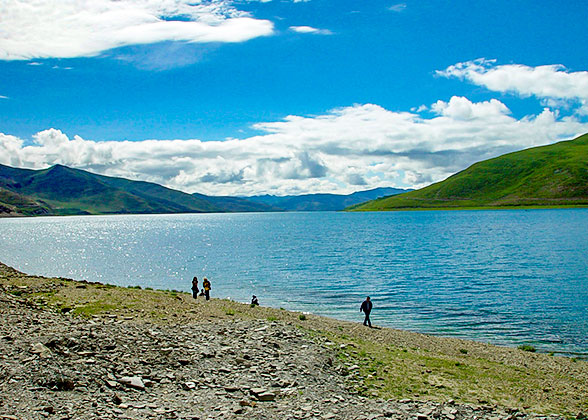
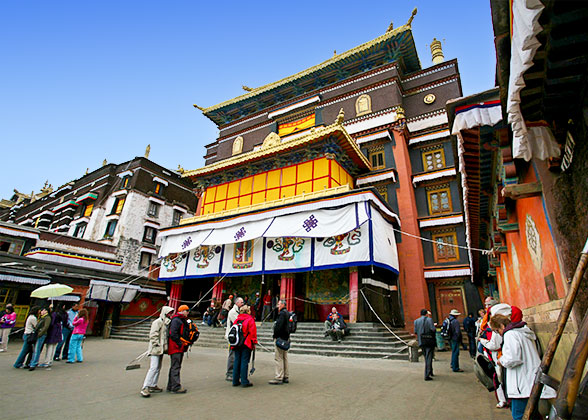
Afterward, continue our journey to the Himalayas. It is the ‘backbone’ of the planet we live on, which spans over 2,400 kilometers (1,491 miles), and also the natural border between China and other countries like India, Nepal, and Bhutan. Boasting 110 peaks over 7,000 meters, including the world’s highest Mt. Everest, it is a paradise for adventure. Standing on the Dingri or Gawula View Point, you’ll see Mt. Everest, which stands proudly at an altitude of 8848 meters (29,028 feet), as if it were a giant finger of the earth reaching towards the sky, wanting to touch the mysteries of the universe. When looking up it, what wells up in your heart may be the endless admiration of the marvelous work of nature. Later in the evening, we’ll finally arrive at the Everest Base Camp, a small community consisting of tents where we are going to stay tonight and some small restaurants that offer simple food. It is a perfect place to get close to Mt. Everest, and if the weather is fine, you’ll have a chance to view the fabulous sunset of golden Everest Peak.
Meals: Western buffet breakfast
Accommodation: EBC Tent Guesthouse (no private washroom)

Yamdrok Yumco Lake

Tashilunpo Monastery
Day 6 Everest Base Camp - Dingri - Gyirong
Enjoy Mt. Everest and visit Rongbuk Monastery in the morning. Proceed to the border town of Gyirong via Dingri. (B)
If Mt. Everest itself is already attractive enough, then its sunrise is even more unforgettable. As the night fades, the sky begins to turn fish-belly white, and then a red sun rises slowly, tinting the mountain a warm orange. Such a stunning scene may make any language seem pale and powerless. After enjoying that accompanied by our guide, pay a visit to Rongbuk Monastery, the temple with the highest altitude in the world. This 120-year-old divine site of the Nyingma Sect is also the only place where monks and nuns live together, and just like other Tibetan temples you have visited, it is always filled with melodious chanting, a faint aroma of butter, and a continuous stream of pilgrims. It is also worth mentioning that it is constantly ‘growing taller’ at a rate of approximately 0.07 centimeters (0.03 inches) per year as the Himalayas on which it sits uplift.
After that, hop in our vehicle again and head to Gyirong Town via Dingri. Along the way, marvel at the natural beauty of Peykuzo Lake, which is known as the ‘Sapphire at the foot of Mt. Everest’, the primitive forest, deep canyons, and other amazing snow-covered mountains. Upon arrival, our guide will send you to a local hotel and help you with check-in.
Meals: Western buffet breakfast
Accommodation: Pingcuo Kangsang Hotel (4 stars) or similar
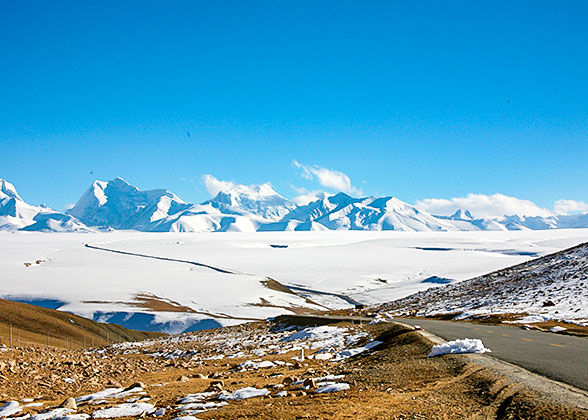
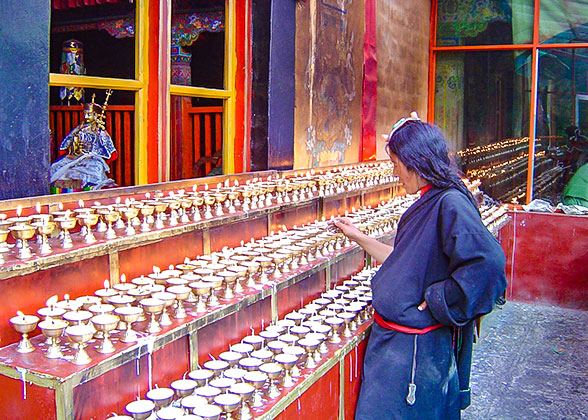
After that, hop in our vehicle again and head to Gyirong Town via Dingri. Along the way, marvel at the natural beauty of Peykuzo Lake, which is known as the ‘Sapphire at the foot of Mt. Everest’, the primitive forest, deep canyons, and other amazing snow-covered mountains. Upon arrival, our guide will send you to a local hotel and help you with check-in.
Meals: Western buffet breakfast
Accommodation: Pingcuo Kangsang Hotel (4 stars) or similar

Mount Everest

Butter Lamps in Tibetan Temple
Day 7 Gyirong - Kathmandu
Exit China through Gyirong Border. Private car transfer to Kathmandu upon request (with extra charge). Wish you a pleasant onward trip! (B)
Your 7 days Tibet group tour to Nepal comes to an end today. After having a hearty breakfast at the hotel, you’ll be transferred by our Tibetan guide to the Gyirong Border, where our Nepalese staff would wait to assist you with the entry formalities and drive you to Kathmandu of Nepal. So far, all of our services have been completed. Hope you had a great time with us!
► Kind Note:
The transfer charge from the Gyirong Border to Kathmandu is not included in our tour price, so you need to pay an extra USD 60 per person if you need this transfer. If you would like to check out more highlights of Kathmandu or other cities in Nepal, please feel free to contact our travel consultant to extend the trip or customize new ones to your satisfaction. If you don’t employ the shuttle service we provide, you can take a public bus from the border by yourself to the bus station of Kathmandu.
Meals: Western buffet breakfast
► Kind Note:
The transfer charge from the Gyirong Border to Kathmandu is not included in our tour price, so you need to pay an extra USD 60 per person if you need this transfer. If you would like to check out more highlights of Kathmandu or other cities in Nepal, please feel free to contact our travel consultant to extend the trip or customize new ones to your satisfaction. If you don’t employ the shuttle service we provide, you can take a public bus from the border by yourself to the bus station of Kathmandu.
Meals: Western buffet breakfast
Expand All
Collapse All
2026 Prices
• Prices are per person on twin sharing.
2025 Prices
Price Includes
- Shuttle service between airport/train station and Lhasa City
- Hotel accommodation with breakfasts
- Meals as itinerary specifies
- Excellent Tibetan English-speaking guide
- Experienced driver & air-conditioned vehicle
- Entrance fees to tourist sites
- Travel accident insurance and high altitude sickness insurance
- On-board oxygen supply for travel in high-altitude areas
- Exquisite Tibetan gifts and travel map
- Tibet Travel Permit
Price Excludes
- Airfares/train fares of arrival and departure
- Border to Kathmandu transfer
- Single room supplement for solo travelers who require single room
- Personal expenses
- Entry visa fees
- Tips for guide and driver
Itineraries you may also like:

